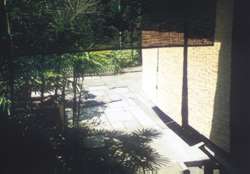| Buildings and houses that have little adverse effect on the environment
are increasingly demanded to protect the global environment. The Department
of Environmental Engineering is developing various methods and technologies
to efficiently build resource and energy-saving, healthy, and comfortable
buildings. It also studies the life styles of people, which are related
to energy consumption, and develops methods for evaluating and examining
the environmental performances of buildings. |
 |
| A Traditional house of kyoto set for summertime. |
|
Research and Development Subject List |
MEMBERS (Last Update: Jul.04,2024)
| Name |
Position |
Research Field |
| Yasuhiro Miki, Dr. |
Director, Department of Environmental Engineering |
Built Environment and Facilities (Evaluation of Light Environment and Visual Environment, Energy Saving) |
| Yasunobu Ashie, Dr. |
Senior Fellow |
Heat Island |
| Yasuo Kuwasawa, Dr. |
Senior Fellow |
Architectural Environmental Engineering (Energy, Thermal Environment, IAQ) |
| Atsuo Hiramitsu, Dr. |
Chief Research Engineer/Chief Research Scientist |
Architectural Acoustics (Floor Impact Noise, Sound Insulation, Measurement and Evaluation, Wooden Buildings) |
| Hisashi Miura, Dr. |
Senior Research Engineer/Senior Research Scientist |
Evaluation of Thermal Performance of Housing Structure, Evaluation of Energy Saving Performance of Residential Heating and Cooling Equipment, Organization of Design Methods for Energy Saving Renovation of Housing
|
| Hiromi Habara, Dr. |
Senior Research Engineer/Senior Research Scientist |
Built Environment and Facilities (Housing, Energy) |
| Eiko Kumakura, Dr. |
Senior Research Engineer/Senior Research Scientist |
Urban and Architectural Environment (Heat Islands, Greening, and Energy-saving of Housing) |
| Tomomi Sano, Dr. |
Research Engineer/Research Scientist |
Architectural Lighting Environment, Architectural Visual Environment (Workability, Comfort, Measurement and Evaluation, Continuity of Office Operations) |
|
|